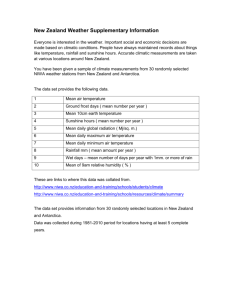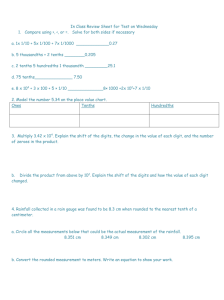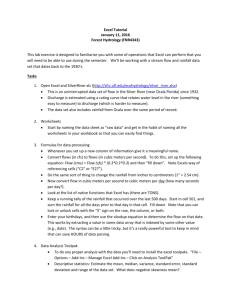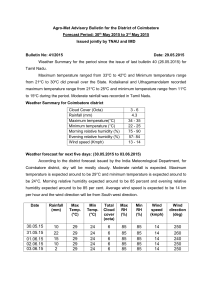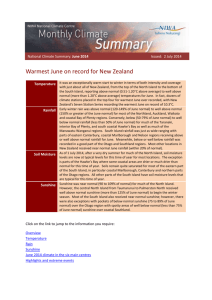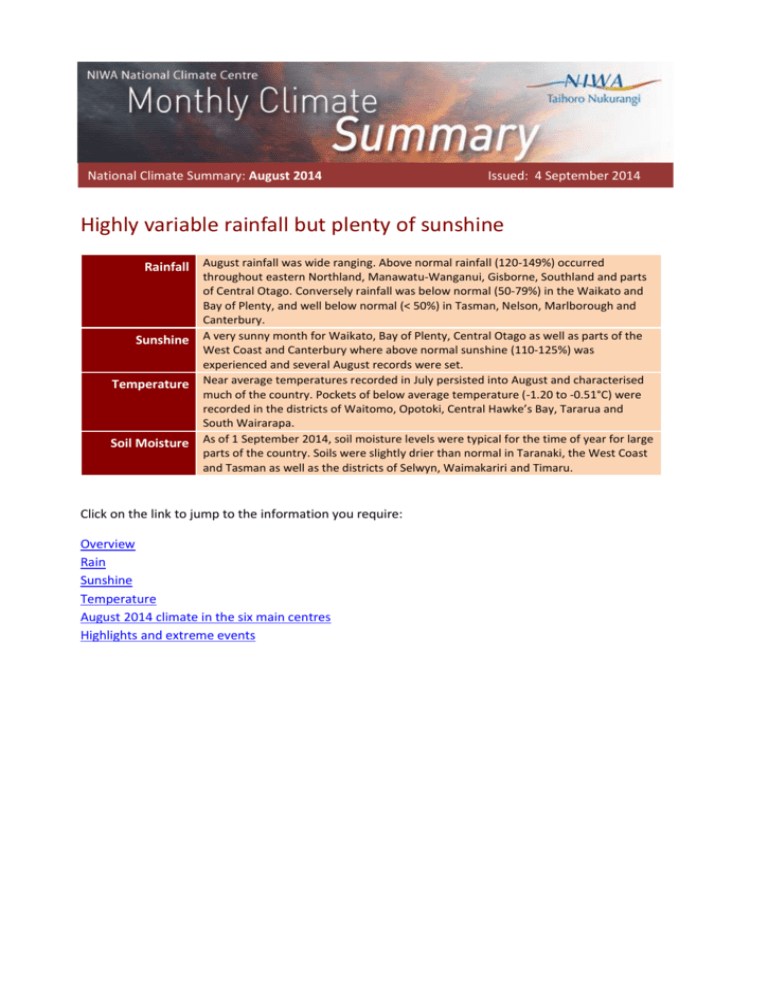
National Climate Summary: August 2014
Issued: 4 September 2014
Highly variable rainfall but plenty of sunshine
Rainfall August rainfall was wide ranging. Above normal rainfall (120-149%) occurred
Sunshine
Temperature
Soil Moisture
throughout eastern Northland, Manawatu-Wanganui, Gisborne, Southland and parts
of Central Otago. Conversely rainfall was below normal (50-79%) in the Waikato and
Bay of Plenty, and well below normal (< 50%) in Tasman, Nelson, Marlborough and
Canterbury.
A very sunny month for Waikato, Bay of Plenty, Central Otago as well as parts of the
West Coast and Canterbury where above normal sunshine (110-125%) was
experienced and several August records were set.
Near average temperatures recorded in July persisted into August and characterised
much of the country. Pockets of below average temperature (-1.20 to -0.51°C) were
recorded in the districts of Waitomo, Opotoki, Central Hawke’s Bay, Tararua and
South Wairarapa.
As of 1 September 2014, soil moisture levels were typical for the time of year for large
parts of the country. Soils were slightly drier than normal in Taranaki, the West Coast
and Tasman as well as the districts of Selwyn, Waimakariri and Timaru.
Click on the link to jump to the information you require:
Overview
Rain
Sunshine
Temperature
August 2014 climate in the six main centres
Highlights and extreme events
Overview
August 2014 was characterised by anomalously high pressure south of Australia extending over and
around New Zealand. This pressure pattern brought about strong south-westerly flow anomalies to the
country.
Rainfall during August was highly variable across the country. Above normal rainfall (120-149%)
occurred throughout eastern Northland, Manawatu-Wanganui, Gisborne and Southland regions as
well as the Central Otago and Mackenzie districts. The largest rainfall anomalies were in Whangarei
and Gisborne where rainfall in excess of 200% of normal occurred. In contrast, dry conditions prevailed
in the Waikato, Bay of Plenty, and the north of the West Coast where below normal rainfall (50-79%)
was experienced. Conditions were even drier in Tasman, Nelson, Marlborough and coastal Canterbury
where well below normal rainfall (< 50%) was observed. As a result, several sites in these regions
experienced near-record low rainfall totals for the month.
A lack of rain in large parts of the country coincided with a very sunny end to winter with well above
normal (>125%) or above normal (110-125%) sunshine recorded for many locations. It was particularly
sunny in the Waikato, Bay of Plenty, Westland, southern Canterbury and Central Otago where well
above normal sunshine was observed and several August records were set. Only two locations (Takaka
and Martinborough) recorded below normal sunshine levels during August.
Soil moisture levels around the country were at field capacity at the start of August 2014 but began to
deplete during the second half of the month. Despite this, as at 1 September soil moisture levels in
most parts of the country remained within the near normal range for the time of year but were slightly
drier than normal in Taranaki, the West Coast and Tasman as well as the districts of Selwyn,
Waimakariri and Timaru.
The near average temperatures observed in July continued into August, with the majority of the
country characterised again by near average temperatures (within 0.5°C of average). In fact
nationwide, only a handful of stations reported above average mean temperatures for August. Small
pockets of below average temperature (-1.20 to -0.51°C) were recorded in the districts of Waitomo,
Opotoki, Central Hawke’s Bay, Tararua and South Wairarapa. Despite the fairly neutral August mean
temperatures, some weather highlights did occur. In particular the 1st-3rd of August were exceptionally
warm all around the country due to a north-westerly flow combined with the foehn effect in eastern
areas. As a result, several locations experienced record or near record high daily maximum and
minimum temperatures. The nation-wide average temperature in August 2014 was 8.7°C (0.1°C above
the 1971-2000 August average from NIWA’s seven station temperature series which begins in 1909)1.
Further Highlights:
1
The highest temperature was 23.6°C, observed at Christchurch (Riccarton) on 2 August.
The lowest temperature was -7.0°C, observed at Middlemarch on 4 August.
The highest 1-day rainfall was 157.2 mm, recorded at Tolaga Bay on 4 August.
The highest wind gust was 189 km/hr, observed at Cape Turnagain on 8 August.
Interim value
Of the six main centres in August 2014, Christchurch was the coolest and driest, Auckland was
the warmest, wettest and cloudiest and Tauranga was the sunniest.
Of the available, regularly reporting sunshine observation sites, the sunniest four centres2 so
far in 2014 (January to August) are: Whakatane (1793 hours), Tauranga (1622 hours), Nelson
(1557 hours) and Lake Tekapo (1554 hours).
For further information, please contact:
Mr Chris Brandolino
NIWA Forecaster – NIWA National Climate Centre
Tel. 09 375 6335, Mobile (027) 886 0014
Rainfall: Both wet and dry around the country
Considerable variances in rainfall totals for August were observed across New Zealand. It was another
wet month for eastern Northland where intense but short lived rainfall events on 19 and 31 August led
to above normal rainfall (120-149%) being recorded for the month as a whole. Above normal rainfall
also occurred throughout the regions of Manawatu-Wanganui, Gisborne and Southland as well as the
Central Otago and Mackenzie districts. Whangarei and Gisborne experienced the largest monthly
rainfall anomalies recording 206% and 209% of normal respectively. Lauder, Gore and Invercargill were
likewise wet, experiencing rainfall totals greater than 140% of normal.
In contrast, many other parts of the country received very little rain throughout the month. Well below
normal rainfall (< 50%) occurred throughout Tasman, Nelson, Marlborough and coastal Canterbury.
Most notably, several locations along the northern coast of the South Island (Takaka, Motueka,
Appleby and Nelson) received near record low rainfall of less than 30% of normal for August. Dry
conditions also prevailed in the Waikato and Bay of Plenty regions as well as Buller and Grey districts
where below normal rainfall (50-79%) was experienced.
The dryness experienced in many parts of New Zealand throughout the month contributed to
decreasing soil moisture levels compared to July. Despite this, as at 1 September soil moisture levels
around most parts of the country remained in the near normal range for the time of year and were
only slightly drier than normal in Taranaki, the West Coast and Tasman as well as the districts of
Selwyn, Waimakariri and Timaru.
Record3 or near-record August rainfall totals were recorded at:
Location
Rainfall total
(mm)
High records or near-records
Lumsden
2
113
Percentage of
normal
Year records
began
Comments
183
1982
2nd-highest
New Plymouth sunshine is still omitted from this ranking while recent instrumentation changes are assessed.
The rankings (1st, 2nd, 3rd.etc) in all Tables in this summary are relative to climate data from a group of nearby
stations, some of which may no longer be operating. The current climate value is compared against all values
from any member of the group, without any regard for homogeneity between one station’s record, and another.
This approach is used due to the practical limitations of performing homogeneity checks in real-time.
3
Low records or near-records
Motueka
Nelson
Appleby
Waipara West
40
20
20
15
28
24
23
23
1943
1941
1932
1973
3rd-lowest
3rd-lowest
3rd-lowest
4th-lowest
Sunshine: A record breaking sunny August
Higher pressure than normal extending over New Zealand during August contributed to sunny skies in
many parts of the country. It was particularly sunny in Waikato, Bay of Plenty, Westland, southern
Canterbury and Central Otago where well above normal sunshine (> 125%) was observed. Record or
near record sunshine August totals were observed at several locations around the country. Most
notably, Queenstown experienced 186 hours (155% of normal) of sunshine during the month which is
the highest August total for this location since records began in 1930. Takaka and Martinborough were
the only locations where below normal sunshine was observed, receiving 89% and 67% of normal
sunshine respectively.
Of the available, regularly reporting sunshine observation sites, the sunniest four centres so far in 2014
(January to August) are: Whakatane (1793 hours), Tauranga (1622 hours), Nelson (1557 hours) and
Lake Tekapo (1554 hours).
Record or near-record August sunshine hours were recorded at:
Location
High records or near-records
Te Kuiti
Taumarunui
Lake Tekapo
Queenstown
Cromwell
Hokitika
Greymouth
Turangi
New Plymouth
Ashburton
Paraparaumu
Low records or near-records
Martinborough
Sunshine
hours
Percentage
of normal
Year
records
began
Comments
171
171
227
186
196
187
182
178
198
188
184
146
150
130
155
131
136
142
128
122
131
120
1962
1947
1928
1930
1979
1912
1947
1976
1972
1930
1953
Highest
Highest
Highest
Highest
Highest
2nd-highest
2nd-highest
3rd-highest
3rd-highest
3rd-highest
4th-highest
99
67
1986
2nd-lowest
Temperature: Near-normal temperatures for most
As a whole, mean temperatures around the country in August were subdued and largely near average
(within 0.5°C of average). In fact, nationwide, only a handful of locations reported above average mean
temperatures for August with Te Puke being the only location experiencing a near record high mean
temperature. Small pockets of below average temperature (-1.20 to -0.51°C) were recorded in the
districts of Waitomo, Opotoki, Central Hawke’s Bay, Tararua and South Wairarapa. The nation-wide
average temperature in August 2014 was 8.7°C (0.1°C above the 1971-2000 August average from
NIWA’s seven station temperature series which begins in 1909).
Record or near-record mean air temperatures for August were recorded at:
Location
Mean
air temp. (oC)
High records or near-records
Te Puke
Low records or near-records
Martinborough
Castlepoint
Departure
from normal
(oC)
Year records
began
Comments
11.2
1.1
1973
3rd-highest
8.0
9.2
-0.9
-1.0
1986
1972
4th-lowest
Equal 4th-lowest
Record or near-record mean maximum air temperatures for August were recorded at:
Location
Mean
maximum
air temp. (oC)
Low records or near-records
Martinborough
Kaitaia
Ngawi
Castlepoint
12.2
14.9
12.0
11.6
Departure
from normal
(oC)
Year records
began
Comments
-1.5
-0.8
-1.4
-1.2
1986
1967
1972
1972
2nd-lowest
3rd-lowest
3rd-lowest
4th-lowest
Record or near-record mean minimum air temperatures for August were recorded at:
Location
Mean
minimum
air temp. (oC)
High records or near-records
Masterton
5.4
Departure from
normal (oC)
Year records
began
Comments
2.6
1992
4th-highest
August climate in the six main centres
Temperatures were near average for all of the six main centres with the exception of Auckland which
experienced above average mean August temperatures. Monthly rainfall totals ranged from near
normal in Auckland to just 30% of normal in Christchurch. Near normal sunshine was recorded in all of
the six main centres. Of the six main centres in August 2014, Christchurch was the coolest and driest,
Auckland was the warmest, wettest and cloudiest and Tauranga was the sunniest.
August 2014 main centre climate statistics:
Temperature
Location
Mean temp. (oC)
Departure from
normal (oC)
Aucklanda
12.2
+0.6
Above average
Taurangab
11.0
+0.2
Near average
Hamiltonc
9.3
-0.3
Near average
Wellingtond
9.2
-0.2
Near average
Christchurche
6.7
-0.5
Near average
Dunedinf
7.6
-0.2
Near average
Location
Rainfall (mm)
% of normal
Aucklanda
125
111%
Near normal
Taurangab
814
73%
Below normal
c
5
84
78%
Below normal
Wellingtond
756
55%
Below normal
Christchurche
18
30%
Well below normal
43
76%
Below normal
Comments
Rainfall
Hamilton
Dunedin
f
Comments
Sunshine
Location
Sunshine (hours)
% of normal
a
150
102%
Near normal
Taurangab
188
109%
Near normal
163
119%
Near normal
157
100%
Near normal
169
110%
Near normal
Auckland
Hamiltong
Wellington
d
Christchurche
Dunedinf
a
4
Mangere
-7
b
Tauranga Airport
c
Hamilton Airport
Missing one day of data from 14 August.
Missing one day of data 29 August.
6
Missing one day of data 20th August.
7
No data due to sensor being replaced.
5
d
Kelburn
e
Comments
-
Christchurch Airport
f
Musselburgh g Ruakura
Highlights and extreme events
Temperatures
The combination of a north-westerly flow and the foehn effect which began on the last day of July
continued into the early days of August. This brought about record breaking daily maximum
temperatures on the 1st, 2nd and 3rd of August at a number of locations around the country. During this
period 13 locations around the country recorded their warmest August daily maximum temperature.
Similarly, the warmest minimum August temperature on record was observed at 37 locations around
the country.
Record or near-record daily maximum air temperatures for August were recorded at:
Location
High records or near-records
Masterton
Dunedin (Musselburgh)
Lumsden
Gore
Tiwai Point
Balclutha
Nugget Point
Reefton
Auckland (Whenuapai)
Dannevirke
Waione
Waipawa
Christchurch (Riccarton)
Wanganui (Spriggens Park)
Queenstown
Masterton
Gisborne
Paraparaumu
Ranfurly
Paeroa
Kaikoura
Kaikohe
Palmerston North
Alexandra
South West Cape
Warkworth
Mahia
Waiau
Cheviot
Extreme
maximum (°C)
20.6
21.7
18.8
19.4
19.1
20.9
19.9
19.4
21.2
20.7
22.1
21.7
23.6
20.6
18.9
20.6
21.7
19.0
18.4
19.9
23.1
19.0
19.7
20.3
15.2
19.9
19.5
21.9
21.8
Date of
extreme
temperature
1st
1st
1st
1st
1st
1st
1st
23rd
2nd
2nd
2nd
2nd
2nd
2nd
1st
2nd
2nd
4th
1st
2nd
2nd
1st
2nd
1st
1st
2nd
2nd
2nd
2nd
Year
records
began
Comments
1992
1947
1982
1971
1970
1964
1970
1960
1945
1951
1991
1945
1863
1937
1871
1906
1905
1953
1975
1947
1963
1973
1918
1983
1991
1966
1990
1974
1982
Highest
Highest
Highest
Highest
Highest
Highest
Highest
Highest
Highest
Highest
Highest
Highest
Highest
Equal highest
2nd-highest
2nd-highest
2nd-highest
Equal 2nd-highest
3rd-highest
3rd-highest
3rd-highest
Equal 3rd-highest
Equal 3rd-highest
4th-highest
4th-highest
4th-highest
4th-highest
4th-highest
4th-highest
Hamilton (Ruakura)
Low records or near-records
Hokitika
19.9
2nd
1906
Equal 4th-highest
6.0
13th
1866
Equal 4th-lowest
Record or near-record daily minimum air temperatures for August were recorded at:
Location
High records or near-records
Cape Reinga
Kaitaia (Airport)
Whangarei
Whitianga
Tauranga
Te Puke
Whakatane
Rotorua
Motu
New Plymouth
Masterton
Dannevirke
Waione
Ngawi
Hicks Bay
Gisborne
Wairoa
Mahia
Paraparaumu
Wellington
Wallaceville
Stratford
Hawera
Farewell Spit
Westport
Greymouth
Haast
Milford Sound
Secretary Island
Hanmer
Kaikoura
Culverden
Winchmore
Waipara West
Orari Estate
Ranfurly
Lumsden
Extreme
minimum (°C)
Date of
extreme
temperature
Year
records
began
15.0
16.0
15.6
15.5
15.4
15.5
15.5
12.6
11.0
13.8
13.9
13.6
14.9
15.1
15.3
16.4
16.1
14.2
13.5
14.2
13.4
12.5
13.0
13.9
12.3
12.9
13.0
11.5
12.6
14.5
12.3
15.9
13.3
16.0
11.9
11.9
11.5
2nd
2nd
3rd
3rd
3rd
3rd
3rd
3rd
3rd
2nd
2nd
1st
1st
2nd
3rd
3rd
3rd
3rd
1st
1st
1st
1st
2nd
2nd
1st
1st
2nd
1st
1st
2nd
1st
2nd
2nd
1st
29th
2nd
1st
1971
1948
1967
1971
1941
1973
1975
1972
1990
1944
1992
1951
1993
1972
1972
1940
1972
1990
1972
1972
1972
1972
1977
1972
1966
1972
1949
1935
1988
1972
1972
1930
1928
1973
1972
1975
1982
Comments
Highest
Highest
Highest
Highest
Highest
Highest
Highest
Highest
Highest
Highest
Highest
Highest
Highest
Highest
Highest
Highest
Highest
Highest
Highest
Highest
Highest
Highest
Highest
Highest
Highest
Highest
Highest
Highest
Highest
Highest
Highest
Highest
Highest
Highest
Highest
Highest
Highest
South West Cape
Kaikohe
Paeroa
Takapau Plains
Castlepoint
Martinborough
Palmerston North
Wanganui (Spriggens Park)
Hokitika
Reefton
Waiau School
Tara Hills
Dunedin (Musselburgh)
Lauder
Lincoln
Wanaka
Manapouri
Alexandra
Nugget Point
Taupo
Turangi
Waipawa
Levin
Ohakune
Low records or near-records
Turangi
Le Bons Bay
Waione
Martinborough
11.0
14.9
14.6
11.1
14.3
14.2
12.7
13.4
12.6
10.3
14.7
8.5
13.3
12.2
12.9
9.4
9.0
11.6
10.5
11.4
10.6
12.2
13.3
9.9
1st
3rd
3rd
1st
1st
1st
1st
2nd
1st
2nd
1st
2nd
1st
2nd
2nd
2nd
1st
2nd
1st
3rd
2nd
2nd
1st
2nd
1991
1973
1971
1972
1972
1986
1940
1972
1866
1972
1974
1949
1947
1924
1881
1972
1973
1983
1972
1950
1968
1945
1950
1972
Highest
Equal highest
2nd-highest
2nd-highest
2nd-highest
2nd-highest
2nd-highest
2nd-highest
2nd-highest
2nd-highest
2nd-highest
2nd-highest
2nd-highest
2nd-highest
Equal 2nd-highest
Equal 2nd-highest
Equal 2nd-highest
Equal 2nd-highest
Equal 2nd-highest
3rd-highest
3rd-highest
3rd-highest
3rd-highest
3rd-highest
-5.9
-0.2
-4.1
-2.8
10th
8th
10th
10th
1968
1984
1991
1986
2nd-lowest
Equal 3rd-lowest
Equal 4th-lowest
Equal 4th-lowest
Rain and slips
On 19 August heavy rain swept through Auckland and Northland with the heaviest rain falling in the
evening. 54.8mm of rain fell in Kerikeri between 6-8pm with the daily rainfall total of 105mm equating
to the 2nd highest on record for August at the time (subsequently moved to 3rd place after even heavier
rainfall on 30 August).
This heavy downpour also affected Rotorua on 20 August where the torrential rain brought flash
flooding to the region. The Fire Service had up to 30 callouts to flooded properties and to rescue
people trapped in vehicles and floodwaters. Some roads were blocked, several homes were evacuated
and some schools closed. The front that brought the heavy rain did not hang around and moved
offshore east later in the day.
On 30 August heavy rain hit Auckland Northland once again. State Highway 10 was closed at Kaeo as
the rain continued through the night and led to extensive flooding. Farmers near Kaeo moved stock to
higher ground as the river flats became cut off. Power to about 250 homes in parts of Kaipara and
Whangarei was also cut off after outages caused by a slip and falling trees, but was restored by the
morning. The 1-day rainfall total in Kerikeri of 115mm set a new station record for the month of
August (records began in 1981 for this station).
Record or near-record August extreme 1-day rainfall totals were recorded at:
Location
Kerikeri
South West Cape
Stratford
Ohakune
Gisborne
Hawera
Extreme 1-day
rainfall
(mm)
Date of
extreme
rainfall
Year
records
began
Comments
115
40
111
52
80
34
30th
1st
2nd
2nd
4th
2nd
1981
1991
1960
1961
1937
1977
Highest
2nd-highest
3rd-highest
3rd-highest
4th-highest
4th-highest
Wind
On 1 August ski fields in the Queenstown area were shut down due to severe gales.
On 2 August a tornado struck Blaketown (Greymouth) tearing off a roof, damaging 10 properties and
leaving three families homeless. No one was reported injured.
On 7 August strong winds snapped wooden power poles near Invercargill and blew out panes of glass
in the city. Also on this day, a bus carrying 18 children was apparently blown off the road near
Eketahuna in the Tararua District. There were no injuries.
On 14 August strong gusts overnight caused vegetation to fall on power lines and brought down power
to more than 1000 homes in West Auckland.
On 15 August strong winds in Wellington closed the harbour ferry crossing.
Record or near-record August extreme wind gusts were recorded at:
Location
Tara Hills
Wanaka
Manapouri
Gore
Paeroa
Levin
Ashburton
Wanganui
Mahia
Hawera
South West Cape
Westport
Extreme wind
gust (km/hr)
Date of
extreme gust
Year records
began
98
93
80
107
96
93
100
96
98
91
165
96
1st
1st
7th
7th
20th
12th
2nd
14th
15th
14th
7th
14th
1985
1992
1991
1987
1991
1971
1970
1977
1991
1986
1991
1973
Comments
Highest
Highest
Highest
Equal highest
2nd-highest
2nd-highest
2nd-highest
Equal 2nd-highest
3rd-highest
3rd-highest
3rd-highest
Equal 3rd-highest
Motu
Baring Head
Winchmore
Kaikohe
Hamilton
Queenstown
93
135
87
80
82
85
2nd
14th
2nd
15th
14th
8th
1991
1991
1970
1986
1978
1972
4th-highest
4th-highest
4th-highest
Equal 4th-highest
Equal 4th-highest
Equal 4th-highest
Snow and ice
On August 7 snow fell overnight in many parts of the south. Snow on August 8 closed all kindergartens,
primary, intermediate and some high schools for the day in Dunedin. No roads were closed in the city,
however no bus service was running in the morning. A number of flights at Queenstown Airport were
cancelled due to snowfall. State Highway 87 from Kyeburn to Outram and SH94 from Te Anau to
Milford Sound (the Milford Road) was also closed due to snow.
On 12 August the Desert Road was closed overnight due to snowfall. Snow had also closed the Milford
Road in the South Island.
On August 14 significant snowfall in the Central Plateau struck again overnight closing the Desert Road.
Black ice on the roads saw several crashes being reported in Taupo and Bay of Plenty with one car
over-turning. At the height of this early evening storm, 13 cars and a truck and trailer unit were
trapped north of Wellington the Rimutaka Hill road summit. Down south state highways 6, 8, 83, 85,
87 and 96 were all closed or partially closed.
On 28 August snowfall affected some of the South Island's alpine passes, with State Highway 73 closed
to towing vehicles from Springfield to Otira. Caution was also advised for those travelling on State
Highway 94, between Te Anau and Milford Sound.
Lightning and Hail
On 4 August a hailstorm hit several Auckland suburbs. The hail blanketed the ground and caused an
office block in Ellerslie to flood.
On 14 August a violent storm of thunder, lightning and hail struck Wellington. Lightning struck the
Zephyrometer sculpture wind needle near Wellington Airport causing it to explode.
Cloud and fog
On 1 August heavy fog caused domestic flight cancellations in Auckland and the delay of some harbour
ferry crossings. The radiation fog was caused by a humid air mass moving over cooler ground
temperatures.
For further information, please contact:
Mr Chris Brandolino
NIWA Forecaster – NIWA National Climate Centre
Tel. 09 375 6335, Mobile (027) 886 0014
For climate data enquiries, please contact:
Ms Nava Fedaeff
Climate Scientist, NIWA Auckland
Tel. 09 375 6337
August 2014 total rainfall,
expressed as a difference from
average.
Considerable variations in rainfall
anomalies were observed across the
country in August. Above normal
rainfall (120-149%) occurred
throughout eastern Far North,
Manawatu-Wanganui, Gisborne,
Southland and parts of Central
Otago. Conversely rainfall was
below normal (50-79%) in the
Waikato and Bay of Plenty, and well
below normal (< 50%) in Tasman,
Nelson, Marlborough and
Canterbury.
http://www.niwa.co.nz/climate © Copyright NIWA 2014.
All rights reserved.

